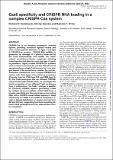Files in this item
Cas6 specificity and CRISPR RNA loading in a complex CRISPR-Cas system
Item metadata
| dc.contributor.author | Sokolowski, Richard David | |
| dc.contributor.author | Graham, Shirley | |
| dc.contributor.author | White, Malcolm F | |
| dc.date.accessioned | 2014-04-22T13:31:02Z | |
| dc.date.available | 2014-04-22T13:31:02Z | |
| dc.date.issued | 2014-06-02 | |
| dc.identifier | 112703281 | |
| dc.identifier | 78fd5bb8-8ae8-4509-b2cf-a36a0b396a38 | |
| dc.identifier | 000338768100041 | |
| dc.identifier | 84903202938 | |
| dc.identifier.citation | Sokolowski , R D , Graham , S & White , M F 2014 , ' Cas6 specificity and CRISPR RNA loading in a complex CRISPR-Cas system ' , Nucleic Acids Research , vol. 42 , no. 10 , pp. 6532-6541 . https://doi.org/10.1093/nar/gku308 | en |
| dc.identifier.issn | 0305-1048 | |
| dc.identifier.other | ORCID: /0000-0003-1543-9342/work/47136104 | |
| dc.identifier.uri | https://hdl.handle.net/10023/4582 | |
| dc.description | This research was funded in part by Biotechnology and Biological Sciences Research Council [BB/K000314/1]. The APC was paid through RCUK OA block grant funds. | en |
| dc.description.abstract | CRISPR-Cas is an adaptive prokaryotic immune system, providing protection against viruses and other mobile genetic elements. In type I and type III CRISPR-Cas systems, CRISPR RNA (crRNA) is generated by cleavage of a primary transcript by the Cas6 endonuclease and loaded into multisubunit surveillance/effector complexes, allowing homology-directed detection and cleavage of invading elements. Highly studied CRISPR-Cas systems such as those in Escherichia coli and Pseudomonas aeruginosa have a single Cas6 enzyme that is an integral subunit of the surveillance complex. By contrast, Sulfolobus solfataricus has a complex CRISPR-Cas system with three types of surveillance complexes (Cascade/type I-A, CSM/type III-A and CMR/type III-B), five Cas6 paralogues and two different CRISPR-repeat families (AB and CD). Here, we investigate the kinetic properties of two different Cas6 paralogues from S. solfataricus. The Cas6-1 subtype is specific for CD-family CRISPR repeats, generating crRNA by multiple turnover catalysis whilst Cas6-3 has a broader specificity and also processes a non-coding RNA with a CRISPR repeat-related sequence. Deep sequencing of crRNA in surveillance complexes reveals a biased distribution of spacers derived from AB and CD loci, suggesting functional coupling between Cas6 paralogues and their downstream effector complexes. | |
| dc.format.extent | 10 | |
| dc.format.extent | 5258417 | |
| dc.language.iso | eng | |
| dc.relation.ispartof | Nucleic Acids Research | en |
| dc.subject | CRISPR-Cas | en |
| dc.subject | Prokaryotic immune system | en |
| dc.subject | CRISPR RNA (crRNA) | en |
| dc.subject | Cas6 | en |
| dc.subject | Sulfolobus solfataricus | en |
| dc.title | Cas6 specificity and CRISPR RNA loading in a complex CRISPR-Cas system | en |
| dc.type | Journal article | en |
| dc.contributor.sponsor | BBSRC | en |
| dc.contributor.sponsor | BBSRC | en |
| dc.contributor.sponsor | BBSRC | en |
| dc.contributor.institution | University of St Andrews. School of Biology | en |
| dc.contributor.institution | University of St Andrews. Biomedical Sciences Research Complex | en |
| dc.identifier.doi | https://doi.org/10.1093/nar/gku308 | |
| dc.description.status | Peer reviewed | en |
| dc.identifier.grantnumber | BB/K000314/1 | en |
| dc.identifier.grantnumber | BB/M000400/1 | en |
| dc.identifier.grantnumber | BB/J005665/1 | en |
This item appears in the following Collection(s)
Items in the St Andrews Research Repository are protected by copyright, with all rights reserved, unless otherwise indicated.

